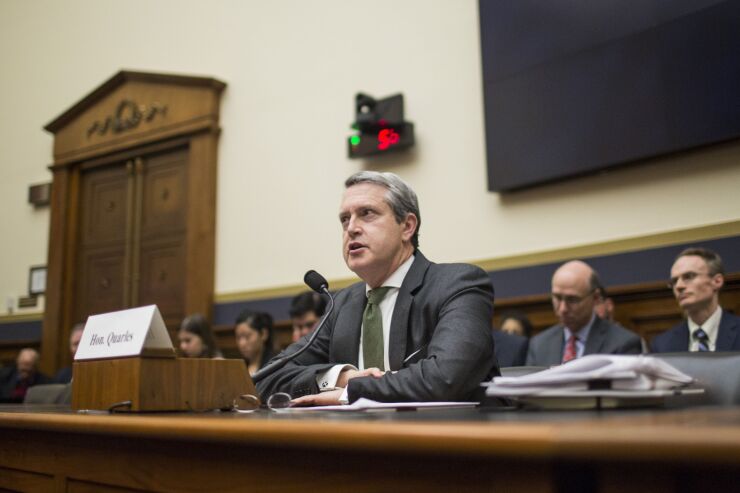WASHINGTON — The Federal Reserve is still mulling whether to permanently adjust a key capital measure for banks due to the massive influx of reserves resulting from the coronavirus pandemic, a top official said Tuesday.
Fed Vice Chairman for Supervision Randal Quarles said he believes “it's likely that something will need to be done” to the supplementary leverage ratio, an extra capital buffer imposed on the biggest banks. The ratio measures capital against an institution's entire balance sheet.
“Right now, the system can't hold the amount of cash that it has without a change,” Quarles said at a virtual event held by Politico.
He noted that when the SLR rule was promulgated in 2014, regulators estimated that reserves at the Fed would total about $25 billion. But because of actions the central bank has taken in response to COVID-19, reserves are now closer to $5 trillion.
The Federal Reserve last spring allowed bank holding companies subject to the supplementary leverage ratio to exclude U.S. Treasury securities and deposits at Federal Reserve banks from the measure of capital relative to assets.

The Federal Deposit Insurance Corp. and the Office of the Comptroller of the Currency later joined the Fed in providing the same relief to banks, though with restrictions on shareholder payouts.
The exemptions were meant to free up resources for banks to make loans and to enable them to absorb an influx of Treasurys. But the move was criticized by some who expressed concern about banks shedding capital in the middle of a crisis.
The banking regulators let the temporary SLR relief
Quarles said the Fed is still weighing the timing of any such proposal to recalibrate the SLR, “including whether something needs to be done” at all.
“There are a variety of ways that one could try to address that so the system can hold that much cash, and yet still have the lending capacity to support the real economy,” said Quarles. “We're looking at whether we need to do any of them, and if so, which would be the right ones to do.”
Senior Fed officials said in March that any potential changes to the SLR would not diminish the strength of current bank capital requirements.
Quarles also said that he didn’t view the SLR as a “ceiling” on how many reserves the Fed can ultimately create.
But he noted that if the Fed were to create excess reserves, “ultimately, that cash would have to be pushed out of the banking system, if that's being required, and do we want it pushed out of the banking system?”
“I'm not sure that's the right answer, which again, is why one would think about whether the calibration of the leverage ratio for this much cash in the system is correct,” he said.
Quarles’s term as vice chair is up in October, and President Biden is not expected to renominate him to the role. But Quarles on Tuesday said he intended to fulfill his term as chair of the Financial Stability Board — which doesn’t end until December — and suggested he would stay on at the Fed as a governor for at least the time being. (His term as a Fed governor doesn’t end until 2032.)
“There’s a tradition in our family, that people serve out their full terms on the Federal Reserve Board of Governors, even if they’re no longer the chair or the vice chair,” he said. His wife is related to Marriner Eccles, a former Fed chair who stayed on as a governor after President Harry Truman opted against renominating him as chair in 1948.
But Quarles said he was unsure if he would stay on at the Fed for all of the 11 years remaining in his term.
“I haven’t decided that yet either,” he said. “I simply note that there’s close familial precedent for it.”





